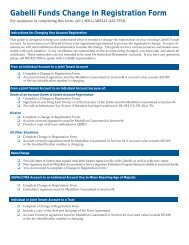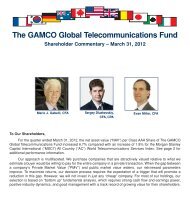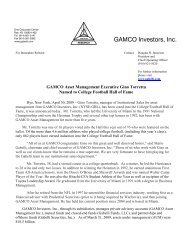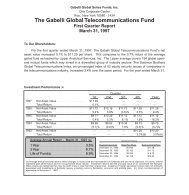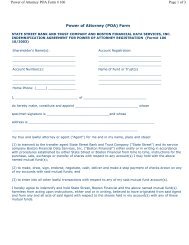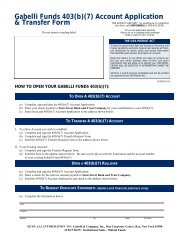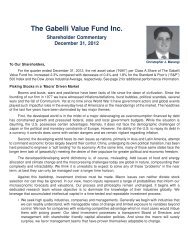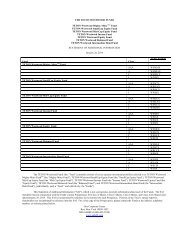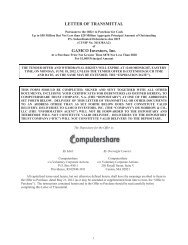FORM 10-K/A GAMCO Investors, Inc. - Gabelli
FORM 10-K/A GAMCO Investors, Inc. - Gabelli
FORM 10-K/A GAMCO Investors, Inc. - Gabelli
- No tags were found...
You also want an ePaper? Increase the reach of your titles
YUMPU automatically turns print PDFs into web optimized ePapers that Google loves.
Our businesses are subject to extensive regulation in the United States, including by the SEC and the NASD. We are also subject to the laws of non-U.S. jurisdictions and non-<br />
U.S. regulatory agencies or bodies. Our failure to comply with applicable laws or regulations could result in fines, suspensions of personnel or other sanctions, including revocation<br />
of our registration or any of our subsidiaries as an investment advisor or broker-dealer. Changes in laws or regulations or in governmental policies could have a material adverse<br />
effect on us. The regulatory matters described in the “Recent Regulatory Developments” section above or other regulatory or compliance matters could also have a material<br />
adverse effect on us.<br />
Our reputation is critical to our success.<br />
Our reputation is critical to maintaining and developing relationships with our clients, Mutual Fund shareholders and third-party intermediaries. In recent years, there have been a<br />
number of well-publicized cases involving fraud, conflicts of interest or other misconduct by individuals in the financial services industry. Misconduct by our staff, or even<br />
unsubstantiated allegations, could result not only in direct financial harm but also harm to our reputation, causing injury to the value of our brands and our ability to retain or attract<br />
assets under management. In addition, in certain circumstances, misconduct on the part of our clients or other parties could damage our reputation. Harm to our reputation could<br />
have a material adverse effect on us.<br />
We face strong competition from numerous and sometimes larger companies.<br />
We compete with numerous investment management companies, stock brokerage and investment banking firms, insurance companies, banks, savings and loan associations and<br />
other financial institutions. Continuing consolidation in the financial services industry has created stronger competitors with greater financial resources and broader distribution<br />
channels than our own. Additionally, competing securities dealers whom we rely upon to distribute our mutual funds also sell their own proprietary funds and investment products,<br />
which could limit the distribution of our investment products. To the extent that existing or potential customers, including securities dealers, decide to invest in or distribute the<br />
products of our competitors, the sales of our products as well as our market share, revenues and net income could decline.<br />
Fee pressures could reduce our profit margins.<br />
There has been a trend toward lower fees in some segments of the investment management industry. In order for us to maintain our fee structure in a competitive environment, we<br />
must be able to provide clients with investment returns and service that will encourage them to be willing to pay such fees. Accordingly, there can be no assurance that we will be<br />
able to maintain our current fee structure. Fee reductions on existing or future new business could have an adverse impact on our profit margins and results of operations.<br />
Risks Related to the Company<br />
The disparity in the voting rights among the classes of shares may have a potential adverse effect on the price of our class A common stock.<br />
The holders of class A common stock and class B common stock have identical rights except that (i) holders of class A common stock are entitled to one vote per share, while<br />
holders of class B common stock are entitled to ten votes per share on all matters to be voted on by shareholders in general, and (ii) holders of class A common stock are not<br />
eligible to vote on matters relating exclusively to class B common stock and vice versa. The differential in voting rights and the ability of our company to issue additional class B<br />
common stock could adversely affect the value of the class A common stock to the extent the investors, or any potential future purchaser of our company, view the superior voting<br />
rights of the class B common stock to have value.<br />
Future sales of our class A common stock in the public market or sales or distributions of our class B commons stock could lower our stock price, and any additional<br />
capital raised by us through the sale of equity or convertible securities may dilute our stockholders’ ownership in us.<br />
We may sell additional shares of class A common stock in subsequent public offerings. We also may issue additional shares of class A common stock or convertible debt securities.<br />
As of December 31, 2006, we had 7,487,018 outstanding shares of class A common stock. On September 1, 2006, a shelf registration statement on Form S-3 was declared<br />
effective by the SEC for the re-sale of up to 2,486,763 class A shares.<br />
37




